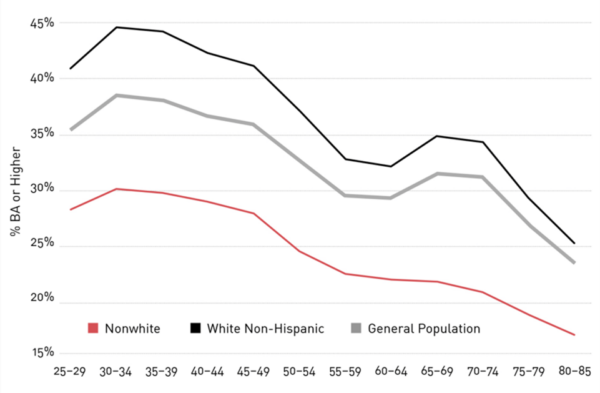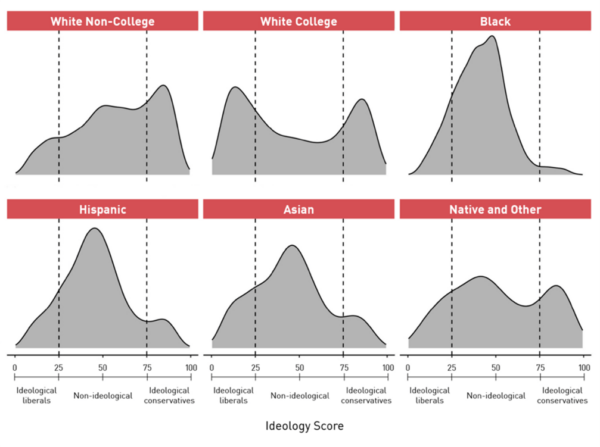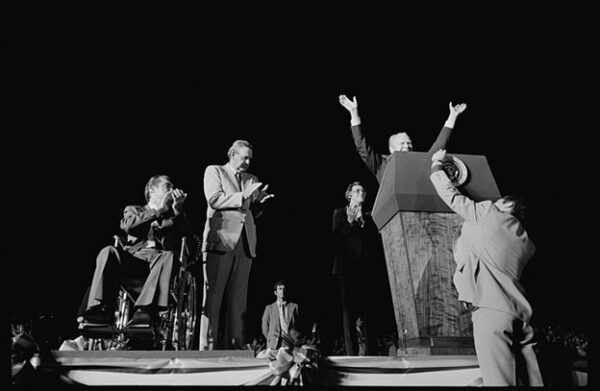Patrick Ruffini, Party of the People: Inside the Multiracial Populist Coalition Remaking the GOP, Simon & Schuster, 2023, 336 pp.
Patrick Ruffini, co-founder of the data analytics firm Echelon Insights, believes that the future of American conservatism lies not with the founding European stock, who are growing increasingly liberal and educated, but with ethnic minorities, particularly Hispanics, who have working-class values, are less likely to go to college, and value hard work.
This thesis is increasingly popular on the American Right, and is embraced by the RNC itself, as well as self-appointed MAGA spokesmen such as Steve Bannon (who recently called South Africans “the most racist people on earth”). Even on its own terms, this analysis falls short, but its popularity makes it worth examining.
Mr. Ruffini’s argument is built on two implicit assumptions: (1) changing trends in immigration, income, and education will not significantly change the voting behavior of non-white groups, and (2) American conservatism is worth preserving.
Income vs. college education
Throughout Party of the People, Mr. Ruffini argues that this “big tent” vision of an emergent multiracial coalition of working-class voters has great electoral power. Indeed, one year after the book was published, he was vindicated when Donald Trump defeated Kamala Harris. For a Republican presidential candidate, Mr. Trump won a record number of Hispanics, and did better than is typical with blacks and Asians. Along the southern border, he was the first Republican in 100 years to win 95-percent-Hispanic Zapata County. In 2020, Mr. Trump also benefited from a 55-point shift in neighboring Starr County from 2016.
White voters without a college degree did not increase their support for the GOP from 2016 to 2020, while whites who have a degree shifted dramatically to the Left since 2012.
This trend went further in the 2024 election. Some exit polls estimated that Miss Harris won college-educated whites by 8 percent and that Mr. Trump won non-college whites by only 34 percent.
Mr. Ruffini argues that income and class (as in “working class” or “middle class”) are less important than the difference between people with and without a college degree. As for income, in 2020, those making more than $200,000 split their ballots evenly between Joe Biden and Mr. Trump, while those making under $30,000 voted for Mr. Biden by an eight-point margin. This put the “income gap” at just 8 percent. Compare this to 1996, when Bill Clinton won the lowest earners by 31 percent and lost the highest earners by 16 percent — a 47-point gap. The 2024 election saw the income gap widen slightly to 10 percent; exit polls indicate that Mr. Trump gained among the poorest voters but lost ground among the richest.
However, the “college gap” grew from 14 points in 2020 to 27 points in 2024. If one assumes that a college education predicts voting behavior more than race does, this could justify a non-racial “populist” strategy for the GOP. And Mr. Ruffini’s data show that non-whites are less likely than whites to attend college.
Mr. Ruffini thinks far too many Americans go to college, and that there is a huge oversupply of people with degrees:
A majority of all jobs — 60 percent — are in occupations where less than 30 percent have college diplomas. The largest group of jobs are those where less than 10 percent of all workers have college diplomas, at 25 percent of the workforce. The top end of the spectrum is not nearly as crowded; only 6 percent are in occupations where 90 percent or more have a college diploma or higher; only 16 percent are in those where that total is 70 percent or more; and 28 percent do work where a majority of their peers are college graduates.
Mr. Ruffini recommends removing degree requirements for many skilled jobs. He notes that during the COVID labor shortages, many companies eliminated degree requirements and instead offered on-the-job training. This is a good policy that would improve the lives of American citizens and would probably also make the electorate more conservative, even if only slightly.
Ideological voters versus persuadable voters
Mr. Ruffini points out that in 2008, Barack Obama did better with whites than exit polls initially suggested. For example, he won nearly 50 percent of the white vote in Michigan. Mr. Ruffini explains that exit polls are continually adjusted for weeks — even months — after an election, which leads to mistaken early post-mortem analyses. The initial results put too much emphasis on the role of non-whites in electing Mr. Obama and underplayed the importance of whites. This is Mr. Ruffini’s point of departure for explaining how black and Hispanic voters could be brought into a right-wing populist movement.
Mr. Ruffini discusses an Echelon Insights survey that tried to identify “ideologues:” people whose views — which may differ from how they vote — align with either party more than 75 percent of the time. College-educated whites are the most ideological. White liberals, who make up 28 percent of all Democrat voters, account for 60 percent of left-wing ideologues in the party. As these graphs show, white conservatives — with or without degrees — tilt strongly toward ideological conservatism:
Ninety-one percent of blacks were classified as non-ideological (even though they vote Democrat by 80-to-90-point margins), as were 70 percent of Hispanics. Somewhat surprisingly, 30 to 40 percent of black and Hispanic voters say they get some or all of their news from Fox.
According to Mr. Ruffini, these results support the idea that both groups are natural conservatives who belong in a big-tent Republican Party. Instead, they show that black and Hispanic voting cannot be explained by political ideology. Even Hispanics, who shifted to the right in 2024, still skew heavily Democrat. Although exit polling suggested that Mr. Trump got 55 percent of the male Hispanic vote, an analysis from the Brookings Institution found that this number was probably closer to 43 percent. While this is a four-point improvement from 2020, it is still underwhelming.
Hispanics and blacks
Mr. Ruffini takes us to the Rio Grande Valley, where he says Hispanics generally favor entitlement programs (such as Social Security and Medicare), but oppose welfare for anyone who chooses not to work. His analysis highlights Javier Villalobos, the Republican mayor of 87-percent-Hispanic McAllen, Texas. He campaigns on taxes and economic development, not culture-wars.
Mr. Ruffini says Mr. Villalobos tapped into the entrepreneurial spirit of American Hispanics. One-eighth have their own businesses, and there was a boom in Hispanic small businesses throughout the 2010s. Hispanics side with working class whites on such issues as systemic racism and American values. They tend to identify as “Americans” rather than as a “hyphenated-Americans,” and they largely reject the push to call themselves “Latinx.” Notably, Hispanic voters are the only electoral bloc in America that follows the “traditional” pattern of voting, in which the rich vote Republican and the poor vote Democrat.
Mr. Ruffini points to rates of interracial marriage as a sign of assimilation. Twenty-seven percent of Hispanics have interracial marriages, second only to 29 percent for Asians. Eighty percent of Hispanic mixed-race marriages are to whites, though “Hispanic” is not a useful racial category: It includes people who are 100 percent Iberian and people from northern South America who are a mix of European, Native, African, and South Asian.
Mr. Ruffini writes that the reason Hispanics have shifted right is not because of “wokeness,” “socialism,” or “religious values,” but because Democrats reward slackers with undeserved welfare. This is a standard right-of-center claim. However, the 2014 Census found that 27.7 percent of all welfare recipients were Hispanic even though the US population was only about 17 percent Hispanic — a 63 percent overrepresentation. Blacks got welfare at a rate 290 percent greater than their proportion of the population.
Regarding black voters, Mr. Ruffini has data indicating that they tend to favor a mix of Left and Right causes. On the Left, they most strongly favor more social spending and anti-racism, but fall slightly left-of-center on crime and immigration. Their right-wing views consist of approval for reduced environmental regulation and a general support for pro-life policies.
Mr. Ruffini highlights Candace Owens and her #Blexit campaign, which appeals to blacks as a group rather than as persuadable individuals. Social pressure, particularly from other blacks, has been shown to play a significant role in shaping black political behavior. Black voting patterns are heavily dependent on their surroundings: Blacks with right-wing views who live among other blacks tend to skew heavily Democrat. Conservative blacks who live among whites, however, tend to vote more Republican, in line with their stated political preferences. Even when taking surveys, blacks are more likely to identify as Democrat when a black asks the questions.
Mr. Ruffini argues that the strongest appeal the Right can make to black voters is economic, not social, even though supporting pro-life policies and reducing environmental regulation could reduce the Right’s votes among moderate and secular white voters.
Despite their strong support for programs such as Medicare-for-All, Mr. Ruffini writes that black voters tend to support moderate rather than radical Democrat candidates. In the 2020 presidential primary, they backed Joe Biden over Bernie Sanders, and in Cleveland, they supported Shontel Brown over the more radical Nina Turner.
Mr. Ruffini explains this by claiming that black political leaders are both “pragmatic” and “moderate,” and encourage blacks to support the candidate with the greatest chance of winning a general election. This sounds appealing, but many factors are involved. Black community leaders are often corrupt, take bribes, and run efficient political machines. In the case of Nina Turner — and after the publication of this book, Cori Bush and Jamal Bowman — radical and anti-Zionist black politicians often fall victim to “shady” campaign financing to put Israeli-friendly opponents into office.
Even if blacks do hold socially conservative views, the GOP has openly embraced “Gays for Trump” and supports a ban on transgenderism only for those under 18. Mr. Ruffini dodges this issue, arguing that abortion and gay marriage are personal matters.
Critique: long-term trends for income, immigration, and education
Mr. Ruffini says “postmaterialism” helps explain recent political trends: Wealth inculcates the rich with leftist politics oriented towards social values. Poorer people care about religion and national identity, and this leads to political polarization. Postmaterialism could therefore destroy any populist coalition because too much prosperity, according to this theory, would produce an entire class of value-voting cultural liberals.
One of Mr. Ruffini’s arguments for courting Hispanic and black voters is their low rates of college graduation, which keeps them conservative. If Hispanics continue to make strides in business ownership and family income, what’s to stop them from sending their children to college, just like whites? What will stop them from reaching the dreaded “postmaterialist” stage?
Furthermore, there is no guarantee that the mix of immigrants will stay heavily Central American or even Hispanic. Mr. Trump granted Venezuelans temporary legal status on his last day in office in his first term, and Mr. Biden open the floodgates to Haitians, Indians, and Chinese. The “tech-bro” wing of the Republican Party wants to issue more H-1B visas and let in yet more Indians, Chinese, and even Nigerians. Mr. Ruffini’s analysis falls apart if new immigrants are already “high-skilled,” college-educated, value-voting liberals.
Is modern conservatism worth conserving?
Mr. Ruffini occasionally alters the past to downplay white racial consciousness and push the idea that non-whites are natural Republicans. He acknowledges the uphill battle conservatives face in wooing black voters, but insists that “[f]or the Party of Lincoln, it is . . . the right thing to do,” conveniently ignoring Lincoln’s sympathies for mass emigration to Liberia. Mr. Ruffini also argues that breaking the Democratic Party’s grip on black voters would improve multiracial democracy — failing to recognize the tensions in nearly every multiethnic society throughout history, a reality acknowledged even by mainstream thinkers such as Yascha Mounk.
When he writes about the 1972 election of Richard Nixon, Mr. Ruffini downplays both the backlash to the Civil Rights Act and the George Wallace campaign, claiming that the “silent majority” was made up of people who didn’t want America to declare defeat in Vietnam. He praises the former mayor of New York, John Lindsay, for putting together a “hardhat conservative” coalition while overlooking the disastrous impacts of forced integration on white communities. He even claims that blacks were strongly motivated by resistance to anti-Vietnam-War student movements.
Mr. Ruffini praises the Civil Rights Act’s prohibition against hiring discrimination and brushes aside objections from Tucker Carlson and the late Sam Francis. Mr. Ruffini chastises the Left for its race obsessions, but claims non-whites still don’t have equal opportunity. He also thinks conservatism requires closing the income gap between whites and blacks. How this differs from the Left escapes me.
Mr. Ruffini also claims that Mr. Trump’s 2016 victory could not have been fueled by racial resentments, because many of Mr. Trump’s ardent supporters were one- or two-time Obama voters. This may be factually true, but Mr. Ruffini downplays the racial concerns of many white voters. As profiles from the New York Times found, every element of the Trump coalition has varying degrees of racial motivation.
On education, Mr. Ruffini fails to mention race preferences in college admissions, which are a serious obstacle to gentile whites who apply to top schools. He says only that unfair admissions drive hardworking Asians away from the Democratic Party — who went on to support Ms. Harris by 15 points. Mr. Ruffini also says that requiring college degrees for middle management jobs discriminates against talented non-whites, who would otherwise add spice to our unbearably white boardrooms. In fact, a report found that in 2021, 94 percent of new jobs at major US companies went to non-whites.
Mr. Ruffini encourages readers with elite aspirations not to apply to Harvard, Princeton, or MIT and aim instead for Arizona State. This may be good advice for a lot of people. but it would lock high-IQ conservatives out of the most prestigious, influential institutions. Mr. Ruffini does acknowledge many Ivy League graduates are social tastemakers, but he believes that they are too liberal to influence the average voter. He ignores the massive leftward shift of the past 80 years, largely driven by these graduates.
A majority of Americans disapproved of interracial marriage when Loving v. Virginia was decided in 1967; now a majority of registered Republicans accept same-sex marriage. Those close to Mr. Trump, including Elon Musk, Vivek Ramaswamy, and J.D. Vance, attended top schools (University of Pennsylvania, Harvard, Yale Law) and are now in positions to promote a civic and color-blind “Nationalist Conservatism.”
Mr. Ruffini offers a trenchant analysis that was partially confirmed by the 2024 presidential election. Mr. Ruffini seems genuinely to want to improve the lives of forgotten Americans. but his prescriptions and biases would ensure that nationalist conservatism stays in the passenger seat, serving the Left.

 RSS
RSS















Not sure what to make of this hodgepodge of drivel (not the author´s fault) …
– It was of course Griggs vs. Duke Power that forced employers to demand
college degrees as a proxy for the ability to read and write; 1950 US public education
was the envy of the world – then came Brown vs. Education; KILL IT.
Like it or not, no society needs more than 15% university graduates; for the US,
more like 10%; introduce either a gaokao or the German numerus clausus
(oh, and in the name of all that is holy kill “university” sports).
– The only other thing of use was the graph on polarization; put simply, it means
that only Whites (and, for some dark and bloody reason, Natives) vote on
(variable-quality) “principles”, everybody else votes gibs; for the electioneer
(Mr. Ruffini) this means it is pointless to woo Whites as they won´t be swayed anyway
(Orange Man ignored that truism, but that proves nothing)
– The two-party sytem is a sickness but it is what the Founders intended; “Israel”
achieves the same Rule by 3% with “multiparty”.
True is as much as the Stupid Party is on the way of becoming the new Workers´.
God speed.
Our host Ron Unz has provided, in the “controversial” HTML books, Erectus Walks Amongst Us. Very few “normies”, and unfortunately even a great many TUR readers, will be unwilling or unable to accept the arguments presented because those arguments conflict with the notion of an invisible god magically and all-of-a-sudden making an Earthful of Homo sapiens. But the book does provide compelling evidence which helps explain our current state of affairs – from fields including, but not limited to, anthropology, chemistry, and history. The nonsense of projecting what “college-educated” (a now meaningless term) sub-Saharan Africans will do in the future is as pointless as giving chimps unlimited quantities of food and believing that they will then build the Parthenon.
Who cares about the Republicans. They are crooks. Just like the Democrats. Your elephant is showing.
Author here, I agree with your assessment. The entirety of the “multiracial populist coalition” worldview is bereft of historical accuracy and any semblance of originality. I tried to keep the subject matter of the review limited to the content of the book to elucidate all of the the internal contradictions and general intellectual poverty behind the author’s ideas.
That being said, I am hoping to expand on these ideas in future essays, hopefully with better source material to draw from. Appreciate your feedback, as this is my first foray into writing about politics. God speed to you as well.
Hispanics are the most plausible allies for Whites, and I mean allies only, because we can’t possibly agree on everything, especially immigration. Unfortunately, we have let ourselves slip to the point where we will be forced to make such alliances.
“Gentile whites”? Jews are not white. Just say whites.
For this reason the deep state throws everything it has against the successful formation of such a coalition, just as it has made long obsolete Third Party political candidacies. Divide and conquer is the sharpest tool of tyranny, expanding the natural fault lines between ethnic and economic rivals. MLK (and Malcolm X) attracted an assassin’s attention only after he expanded the civil rights struggle to include poor whites as well as blacks.
I suspect Trump won in 2024 for the same reason Lincoln won in 1860, not that people so much supported the GOP platform, but because the electorate was appalled by the staggering corruption of the Democratic Party.
Educated people tend to be liberals – you have said a mouthful there, brother. Those of us who value the life of the mind carry memories of being bullied by what we think of as the knuckle-dragging element in our dear old school days. Sorry, it is still an effort to respect people who take such transparent BS as patriotism, religion, and sports seriously, as if they were real things and not oligarchy’s carefully constructed control mechanisms. Tell you what, the top tenth of the one percent, who make all the decisions globally, hate and fear their loyal plebeians just as much as they abhor people who think rationally rather than react emotionally. To some of us it seems that the True Believer crowd is so used to being pissed on that they want to literally kill those of us who try to point out to them that rain isn’t naturally hot and yellow.
Hispanics are the most plausible allies for Whites, and I mean allies only, because we can’t possibly agree on everything, especially immigration. Unfortunately, we have let ourselves slip to the point where we will be forced to make such alliances.
No doubt about it. I can see a functional future for a supermajority White/Hispanic America. Indeed, I suspect this is the chief concern of the Plutocracy right now. It’s unfortunate that Whites won’t have uncompromised political representation, but then if a substantial number of Hispanics will vote for a Republican party that supports reasonable pro-White policies, the Left can hardly use demographic triumphalism to intimidate the Republicans into continual pandering to Hispanics at the expense of Whites, even on immigration.
Whites and Hispanics have enough in common culturally, historically, and even genetically to form an effective alliance against the money power. An immigration moratorium would go a long way to breaking old country ties and solidifying American identity and loyalty among Hispanics. A return to law and order, likely to be popular among Hispanics, would remove the dregs from the gene pool and make affordable neighborhoods more liveable.
Politics has been defined by a coalition of the fringes against the White majority for decades now. I see no reason why Whites couldn’t turn the tables and lead a populist coalition against the elites that now define the Democratic party. We don’t even need all that many Hispanics, a few percentage points’ growth each election cycle would do nicely. This possibility is, I believe keeping certain people up at night and haunting their dreams. Their defense will be to attempt an H1B tsunami. They must not succeed.
Haven’t we already been through this “Hispanics are natural conservatives” in the Bush II era? Hispanics (who, as someone usually points out, include a wide range of racial characteristics and national origins) may be conservative on issues that matter to them. That doesn’t mean they are “pro-White.”
If Hispanics are temporarily allied with whites in particular categories like immigration — perhaps they’re against foreign colonization from non-Hispanic countries — well and good. We can welcome their support, limited though it may be. But the record shows that the attempt to win over minority groups in massive proportions has been a damp squib and is likely to remain so as far as the eye can see.
I didn’t say they were pro-White.
Look. I don’t know what you’re talking about here. Do you not understand what happened in November? The Democrats thought they could continue to whore themselves out to the multinational corporatocracy while winning elections by whipping up hysterical fear and hatred of Joe and Jane Sixpack. The Hispanics appear to be smarter than any of us gave them credit for. The good news is that we don’t have to pander to them on immigration, so the Republicans no longer have any excuse.
Multiracialist populism is just another variation of controlled opposition.
Populist should aim for the elite using these astroturf poseurs as decoy agents infiltrating all sides.